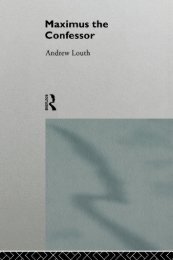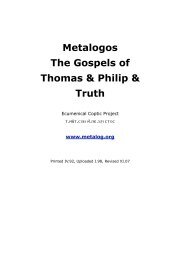Gospels of Thomas and Philip and Truth - Syriac Christian Church
Gospels of Thomas and Philip and Truth - Syriac Christian Church
Gospels of Thomas and Philip and Truth - Syriac Christian Church
You also want an ePaper? Increase the reach of your titles
YUMPU automatically turns print PDFs into web optimized ePapers that Google loves.
wood, iron, water— are not “matter”; they are sensible realities.... If we wish to refer<br />
to the sensible as “matter”, there can be no objection. It is just a question <strong>of</strong> words.<br />
But then we must make quite sure <strong>of</strong> our meaning <strong>and</strong> not refer to ... an<br />
inconceivable “material substance”.’ (Biblio.18; in the Middle Ages, the Jewish<br />
philosophers adopted the term mlg [golem, embryo; only in Ps 139:16] to signify<br />
matter)<br />
II. (Th 19 22 36 50 67 80 83, Ph 24 26 81 84 95) Starting with this implicit axiom<br />
that there can be no such thing as ‘matter’ (that being, in our modern phrase, an<br />
essentially non-referential term), the texts proceed to designate our entire sensory<br />
field as ‘imagery’ (‘icons’). This latter therefore serves as a collective term for what<br />
recent philosophers have called ‘phenomena’ or ‘sense-data’— including one’s<br />
interior soliloquy, memories, emotions <strong>and</strong> fantasies, as well as those perceptions<br />
which comprise one's individual incarnation together with its empirical environment.<br />
III. (Th 37 42, Ph 9 30 47 85 112) But imagery logically presupposes<br />
consciousness. One’s correspondingly juxtaposed individual ego is then designated<br />
as an ‘angel’, a pure awareness which like a mirror ‘reflects’ (contemplates) its<br />
spacio-temporal complex <strong>of</strong> sensory images. In this way, the angel is said to be<br />
‘mated’ with its imagery. Furthermore, as all space <strong>and</strong> time are merely relations<br />
among the images, the angel is itself non-spacio-temporal or ‘eternal’; thus Jn 5:19<br />
[extrapolated]: A Son ‘can do nothing <strong>of</strong> his own accord, but only what he sees the<br />
Father doing’; also Lk 20:34-36!<br />
IV. (Mt 18:10, Th 5 15 17 52 59 76 91, Ph 65 107) Therefore there is a<br />
Universal Consciousness corresponding to the meta-totality <strong>of</strong> all imagery; this<br />
superego is by definition God (Gen 1:26, ‘in our imagination’).¹ Each person or angel<br />
is thus like a mirror in the mind <strong>of</strong> God, individually reflecting in his five senses the<br />
plethora <strong>of</strong> the divine imagination. (This importantly does not entail that everyone be<br />
explicitly cognizant <strong>of</strong> that relation, which presumably requires instruction by the<br />
Logos.) There is here a lovely word-play on ΕΙΚΩΝ: our sensory images are<br />
themselves holy icons. (¹Victor Hugo, Les Misérables: ‘All the aspects <strong>of</strong> things are<br />
thoughts <strong>of</strong> God’; Anton Chekhov, The Sea Gull: ‘The common soul <strong>of</strong> the world is<br />
the I.’)<br />
V. Thus, regarding the primordial query <strong>of</strong> Thales <strong>of</strong> Miletus (625-546 BC) as to<br />
the basic substance <strong>of</strong> the perceptible Universe— from which all subsequent<br />
scientific <strong>and</strong> philosophical inquiry arose— Christ appears to have taught that it is<br />
121




